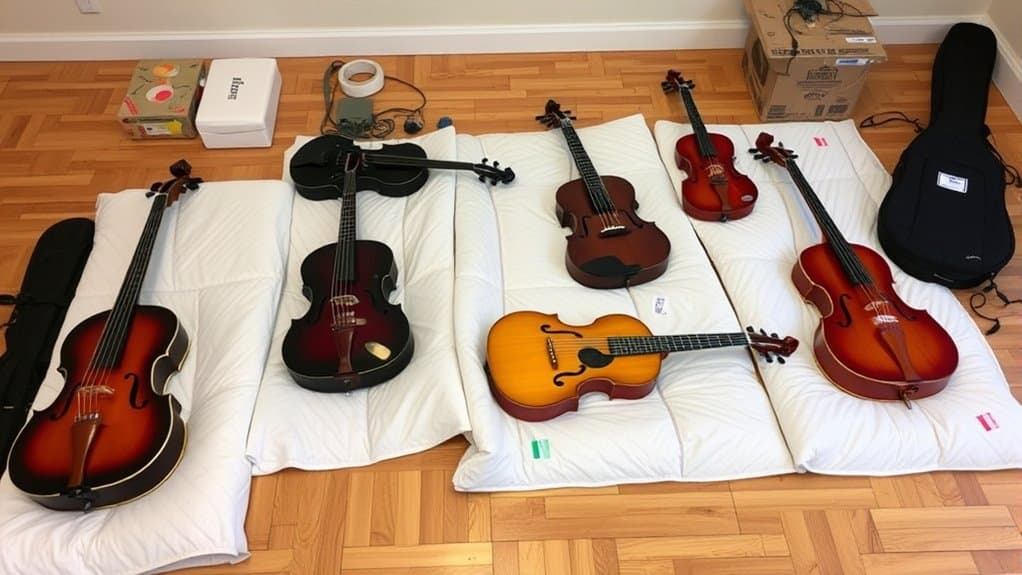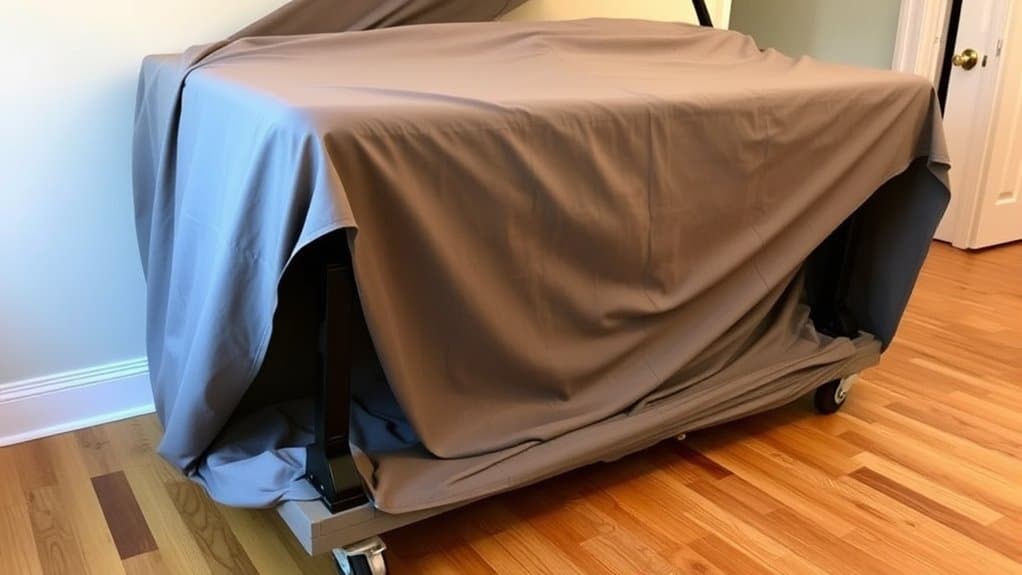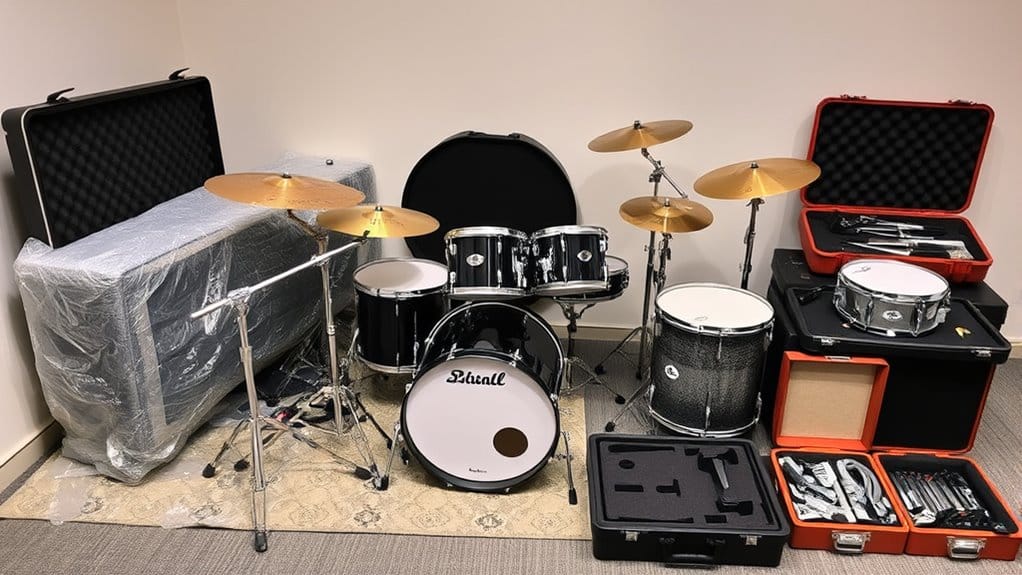To safely move musical instruments, you'll need to properly prepare and protect each type differently. For string instruments, loosen the strings and use protective covers. Wind and brass pieces should be disassembled and wrapped carefully in bubble wrap. Keyboards and pianos require specialized padding and professional movers, while percussion sets need individual wrapping for each component. Proper insurance coverage and climate-controlled transport are essential for valuable pieces. These fundamentals will set you up for a successful instrument relocation.
Essential Preparation Steps Before Moving Instruments

When you're preparing to move musical instruments, proper planning and preparation are absolutely essential to guarantee their safe transport. Start with a thorough instrument assessment, measuring dimensions and weight to determine handling requirements.
You'll need to verify these measurements against doorways, hallways, and stairwells in both locations.
Next, gather all necessary packing materials, including moving blankets, bubble wrap, and specialized cases for temperature-sensitive items.
Don't forget to source heavy-duty tape and appropriate filler materials to prevent shifting during transport. For larger instruments like pianos, you'll want to contact professional movers who've the right equipment and expertise. It's important to consider that pianos weigh between 500 lbs – 1300 lbs, making them particularly challenging to move without assistance.
Make sure to document any unique features that might affect transport, such as removable parts or delicate components that need extra protection.
Special Care for String Instruments
String instruments require exceptional attention during the moving process due to their delicate construction and valuable components. When preparing your instrument for transport, you'll need to focus on proper tension adjustment and protective measures to guarantee its safety.
Temperature management and humidity control are vital factors that can affect your instrument's condition during the move.
- Loosen string tension before transport to reduce stress on the neck and bridge, but don't completely detach the strings from your instrument.
- Use specialized protective covers and bridge guards to prevent damage to critical components, guaranteeing proper padding around tuning pegs.
- Pack your instrument in a high-quality hard case with appropriate packing materials, including moisture-absorbing silica gel packets.
- Monitor temperature and humidity levels during storage and transport, maintaining consistent environmental conditions to prevent wood warping.
Proper Handling of Wind and Brass Equipment
Proper handling of wind and brass instruments requires a systematic approach to disassembly and protection before any move.
You'll need to break down your instruments into their smallest components, ensuring proper brass maintenance and woodwind storage throughout the process. Start by removing all detachable parts, including reeds, mouthpieces, and valves, storing them in labeled bags for safekeeping.
Wrap larger sections in bubble wrap and secure them with tape, paying special attention to delicate mechanisms. If you've got original hard cases, they're your best option for protection. Otherwise, invest in sturdy alternatives with proper padding.
Don't forget to fill empty spaces with foam peanuts or packing paper, but avoid over-packing, which can damage sensitive components. Keep everything upright during transport, and document your disassembly steps for easier reassembly later.
Safe Transport of Keyboards and Pianos

When you're moving a piano or keyboard, you'll need to start by securing all internal components and locking the lid to prevent any shifting during transport.
For grand pianos, you'll want to use specialized piano shoes and proper jacking techniques, while upright pianos require 2×4 blocks for stability and careful navigation through tight spaces.
Your success in safely transporting these instruments depends on using appropriate protective materials like thick blankets, bubble wrap, and furniture pads to shield against potential damage during the move.
Keyboard Protection Essentials
Safely transporting keyboards and pianos requires meticulous attention to their delicate components and internal mechanisms. When preparing your keyboard for transport, focus on protecting essential components while maintaining the instrument's structural integrity.
Key keyboard maintenance tips and soundboard care include:
- Cover the keys with a soft cotton cloth before securing the lid with built-in locks or stretch wrap.
- Apply professional-grade moving blankets as shock absorbers, followed by secure shrink wrapping.
- Install edge protectors on vulnerable corners and stabilize internal components to prevent movement.
- Lock or disable casters, and use carpentry skid boards with carpeted surfaces for support.
Remember to maintain an upright position during transport and distribute weight evenly on dollies.
You'll want to check regularly for moisture buildup and minimize sudden movements that could cause internal damage. Additionally, consider hiring Expert Piano Movers to ensure safe and efficient transport of your instrument.
Moving Piano Step-by-Step
Moving a piano successfully demands detailed planning and methodical execution at every stage. Before you begin, measure all pathways and doorways to guarantee proper clearance, and gather essential equipment like dollies, straps, and moving blankets.
When implementing piano lifting techniques, secure loose components and protect surfaces with padding to prevent damage.
For piano transport safety, you'll need to wrap the instrument completely in moving blankets and secure it with adjustable straps. Position your team strategically, with one person directing movements and 2-3 others managing balance and steering.
As you navigate through your planned route, use gradual movements and clear communication. Don't forget to protect corners with foam guards and place non-slip pads under the piano's legs or dolly wheels to prevent unwanted movement during transport.
Best Practices for Moving Percussion Sets

When you're ready to move your drum set, you'll need to start by completely dismantling each component, including removing all mounting hardware and carefully organizing small parts into labeled bags.
Your cymbals require special attention, so wrap each one individually in soft cloth or bubble wrap, and store them flat in their original cases or specialized cymbal bags.
For maximum protection during transport, you'll want to pack your drums in their hard cases or sturdy boxes with plenty of padding, making sure to cushion the bearing edges and wrap tension rods separately to prevent damage to the shells.
Drum Set Disassembly Steps
A successful drum set disassembly requires five essential preparation steps before you begin the moving process.
When following these drum maintenance tips, you'll need proper packing materials and a systematic approach to guarantee all components stay protected during transport.
- Remove wing nuts and felts from cymbals first, storing them in labeled bags to prevent loss.
- Detach tom arms and cymbal stands using a drum key, keeping hardware organized.
- Dismantle the bass drum components, including legs and mounting hardware.
- Pack shells separately with non-abrasive padding, avoiding direct contact between pieces.
Before sealing your cases, document the assembly with photos for reference later.
Don't rush the process - careful disassembly now will save you time and frustration during setup.
Remember to secure all small parts in sealed containers and protect your cases with reliable locks.
Cymbal Protection Essentials
Properly protecting your cymbals during transport requires specialized equipment and careful attention to detail.
Start by investing in hard-shell cases with secure compartments and adequate padding to prevent damage during movement. When it comes to cymbal stacking, arrange them from largest to smallest, using soft cloths between layers to prevent metal-to-metal contact.
Equip your cymbals with protective sleeves or dedicated Cymbag covers for individual protection, and always keep edges pointing upward to avoid warping.
Don't stack more than 3-4 cymbals together, and use dividers to maintain separation. Before packing, clean each cymbal thoroughly and inspect for any existing damage.
Label your cases clearly for easy identification, and make sure all compartments are properly secured before transport.
When and Why to Hire Professional Movers
Moving valuable musical instruments requires careful consideration of when professional assistance becomes necessary.
Professional expertise guarantees safe handling during complex relocations, while minimizing risks to your cherished instruments. When you're dealing with delicate or large instruments, the relocation benefits often outweigh the costs.
Consider hiring professionals when:
- You're moving full-size pianos, organs, or multiple large instruments that require specialized equipment
- Your instruments need climate-controlled transport to maintain their integrity
- You're facing challenging logistics like narrow staircases or long-distance moves
- You have rare or high-value instruments that demand expert handling and insurance coverage
These experts come equipped with purpose-built tools, proven techniques, and thorough knowledge of instrument-specific requirements. Hiring full service movers can significantly enhance the safety and efficiency of your moving experience.
They'll handle everything from proper padding and wrapping to secure loading and transportation, giving you peace of mind throughout the moving process.
Insurance and Protection During Transit
Professional movers offer valuable protection, but securing appropriate insurance coverage remains a critical safeguard for your musical instruments during transit.
Standard homeowners' policies typically limit coverage to around $1,000, which often isn't enough for valuable instruments. You'll need to explore specialized coverage options that protect against transit risks.
You've got two main choices: full-value coverage, which reimburses total replacement costs, or declared-value coverage, which offers lower premiums but caps reimbursement at a pre-stated amount.
To maintain coverage validity, you'll need to use licensed, insured movers and follow specific packing requirements. Make sure your instruments are properly stored in appropriate cases, and keep detailed documentation including receipts and appraisals.
If you're moving high-value instruments, you may need additional security measures like GPS tracking or reinforced cases. Additionally, it's important to understand your coverage options as this can impact the level of protection you receive during the move.
Conclusion
Protecting and preserving your precious musical instruments during a move requires proper planning and purposeful packing. You'll find that following these focused fundamentals makes the difference between safe arrival and costly repairs. Whether you're transporting tubas or transferring timpani, remember to secure, stabilize, and shield each instrument appropriately. When in doubt, don't hesitate to hire professional movers who specialize in musical equipment transport - they'll guarantee your instruments arrive intact and in tune.



